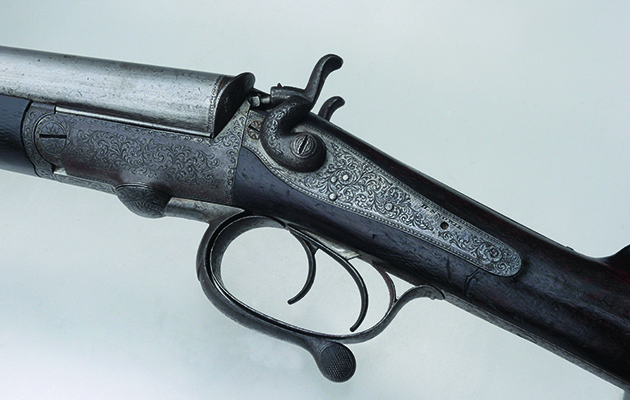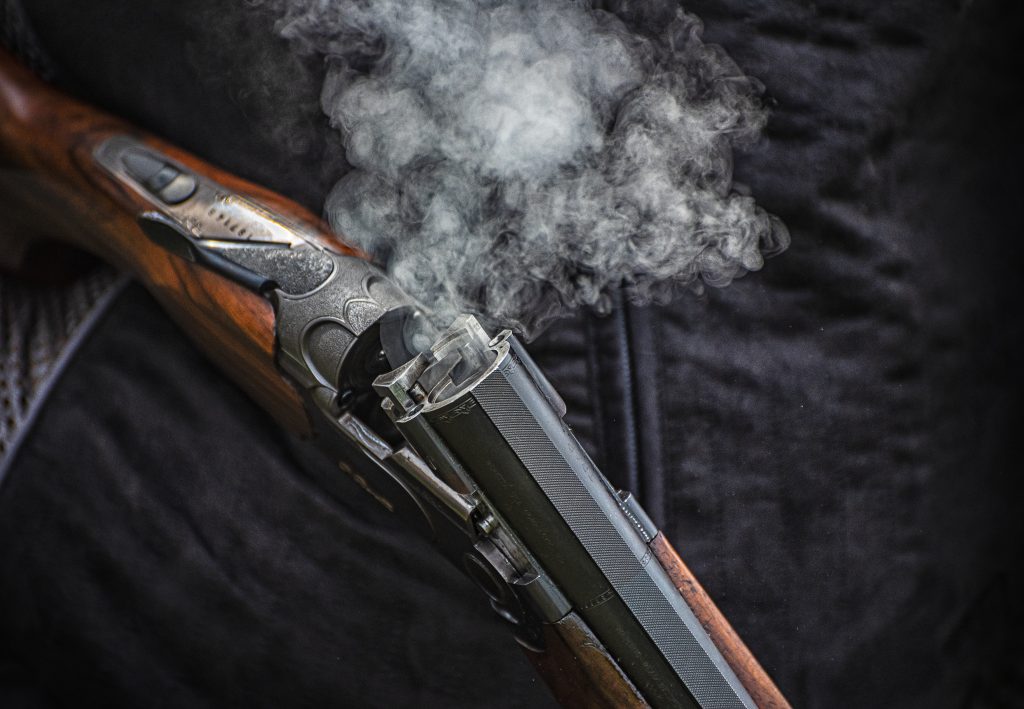Win CENS ProFlex DX5 earplugs worth £1,149 – enter here
Snowie 12-bore
 Beautiful styling, stunning engraving
Beautiful styling, stunning engraving
The growth of interest over the past few years in hammerguns has undoubtedly saved shotguns that would otherwise have been left to rust away or be scrapped off. While older shooters seeking a bit of nostalgia or newcomers fascinated by the earlier technology often prefer a tidy, restored piece, unrestored guns, if otherwise in sound condition, can be a more economic buy. The Snowie is in need of some TLC, but ignoring the polished barrels, worn chequering and grimy stock, it has some interesting features.
H. Snowie is not a name that automatically springs to mind as a gunmaker but Hugh Snowie is listed as being in business from 1878 until 1909, by which time it was Hugh Snowie & Son. It is possible that the origins of the company stretched back as far as 1850, but whatever the full facts, the Snowies of Church Street, Inverness, appeared to operate a thriving business.
Smaller makers tended to subcontract a lot of the major work and parts and how much of this shotgun can be attributed to Snowie is not possible to say. It is not unknown, though, for Scottish makers, in locations remote from the great gun workshop of Birmingham, to carry out much of the work in-house. There are also features that suggest Hugh Snowie had his own ideas on styling detail that have left us with a particularly elegant and distinctive shotgun.
Beautifully raised fences
This Snowie is, of course, blackpowder proof and carries London proof marks on the Damascus barrels. It has the thin-walled breeches typical of early breechloaders and the fore-end is held by a cross-bolt, the same as a muzzle-loader. Another feature from the muzzle-loading years is the beautifully raised fences in front of the hammer.
The method of locking uses Henry Jones’ famous double screw-grip underlever which dates from 1859 but the shaping of this lever and the way it follows the lines of the trigger-guard is far better than most examples. While the action body is beautifully shaped, more a tapered body than a round body, it is not an especially strong design. In fact, if one removes the cross-pin that the barrels hinge on together with the cam that operates the extractor, the action bar is cut open at the middle of the knuckle.
Features worthy of note include the extraordinarily long one-piece trigger-plate and tang which extends from just behind the underlever pivot to some 10¼in down the stock, while the trigger-guard is fitted separately. To mirror the long tang is a long top strap, held by both a breech pin and hand pin, making for a strong assembly.
The locks are rebounding (or single cocking locks), meaning there is no manual half-cock position; the at-rest position of the hammers is effectively half-cock. As for the engraving, it is delightful work — bold but classy with a chevron border around the lockplates.
In spite of its lithe looks, this Snowie weighs in at more than 7¼lb, though some of that is thanks to the stock with its heavy butt and steel heel plate (again, features of the earlier muzzle-loader). That is part of what makes this shotgun a classic, as well as the obvious good build quality and distinctive looks. It’s a transition piece from muzzle-loader to breechloader, typical of the careful and conservative evolution of design that made shotguns from this island world-famous — and this one a credit to a little-known Scottish maker.
What to look for when buying a secondhand Snowie
Barrels: Check for pitting, dents, bulges and proof (bore) sizes
Action: There is little to go wrong with a hammergun,but wear will occur on the cross-pin and barrel hook and sometimes on the Jones screw mechanism
Weight: 7lb 6oz
Value: Prices vary greatly: a gun that’s unrestored but in proof — circa £350-£400; if it’s restored — anything up to £2,000. It has been very much a seller’s market, but the signs are this is beginning to change.
Related Articles
Get the latest news delivered direct to your door
Subscribe to Shooting Times & Country
Discover the ultimate companion for field sports enthusiasts with Shooting Times & Country Magazine, the UK’s leading weekly publication that has been at the forefront of shooting culture since 1882. Subscribers gain access to expert tips, comprehensive gear reviews, seasonal advice and a vibrant community of like-minded shooters.
Save on shop price when you subscribe with weekly issues featuring in-depth articles on gundog training, exclusive member offers and access to the digital back issue library. A Shooting Times & Country subscription is more than a magazine, don’t just read about the countryside; immerse yourself in its most authoritative and engaging publication.







